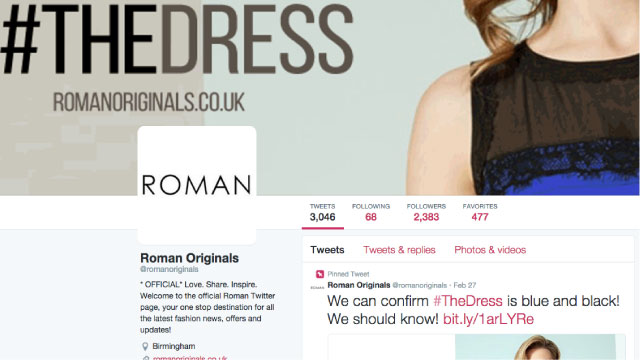
How does a smart business handle a massive, worldwide rush of attention and increase in sales, especially when it comes out of nowhere?
If you’ve been anywhere near the Internet in the last few days, you’ve certainly heard about “the dress.” A random post became an international sensation, with Buzzfeed measuring over 38 million hits to its post on this very simple (but addictive) topic. Whether you see it as white and gold, or blue and black, we can all agree that, for the small retailer that sells this dress, things are looking pretty green (and possibly a bit overwhelming) right now.
The Business Behind the Dress
Roman Originals, the company behind the infamous dress (which is actually blue and black) is a family-owned business in the U.K. Originally founded in 1957 as a manufacturing business, it’s evolved into a designer, manufacturer, and, since the late 1990s, a retailer of ladies’ clothing and accessories. There are now over 150 Roman stores across the country.
So how has this fifty-year old business, self-described as a “design led and fashion forward retailer,” handled the unbelievable, and totally unexpected, amount of attention garnered by the Internet’s sudden obsession with tone of its dresses?
Pretty darn well, actually.

Before-and-After: By the Numbers
On Thursday evening, February 26, the photo was posted to Tumblr.
On Friday, sales of the dress – which retails for £50 (about $75 US) – accounted for 60% of the company’s total business, according to Ian Johnson, Roman’s creative manager.
Today, total sales for the company are up about 350%, according to a Roman spokesperson. And though Twitter fans (around 2,000) and Facebook followers (approximately 20,000) haven’t spiked into the hundreds of thousands, the Roman Originals website is experiencing a 2000% increase in traffic from its previous best days.
How Roman Originals Has Responded
Roman Originals is a business already in the thick of quick response and growth: they add an average of 20 new designs each week in stores, and they’re adding about one new store location a week.
They were quick to respond to the international buzz of their blue-and-black (or white-and-gold) dress on social media.
Both Twitter and Facebook now have #thedress-related headers, and multiple updates related to the dress, including one which confirms the color as blue and black.

Roman has also added the dress to its daily dress giveaway, promoted via Facebook, with winners announced on the website. The front page of the website is dedicated to the dress: a large header, complete with hashtag, declares that the elusive thing is back in stock.
Then, of course, there’s the product launch — releasing an actual white-and-gold version of the dress. Michelle Bastock, Roman’s fashion director, said one will appear very soon. However, the six-month delay before market availability may mean a total loss of the current Internet hyper-interest.
To keep riding the wave of viral attention, Roman decided to manufacture a single white-and-gold dress immediately, which will be unveiled on their Facebook page and then auctioned off for charity.

5 Tips to Handle, and Maximize, Sudden Attention If It Comes Your Way
1. Though public attention and media frenzy are certainly unpredictable, they’re also useful. Smart business owners will turn attention into sales, and one-time sales into loyal customers.
2. When the attention comes, you must respond immediately. Turn-around time for news has always been quick, but the Internet age has compressed it from days to hours. Don’t hesitate to respond to sudden attention. Gather your key players, come up with a strategy, and respond.
3. Remember that attention only converts to dollars if you’re ready to provide opportunities for sales. Internet users are quick to click and quick to spend on the products or businesses that grab their interest — but that interest is just as quickly lost.
4. Make sure that your response matches the context and tone of the attention your business is receiving. If it’s a light-hearted Internet debate (like this one – though at times the debate did get heated), then a dose of humor fits perfectly. If it’s a more somber topic or discussion, however, then your tone should match accordingly.
5. Get creative with ways to capture user information, such as an email list, and with ideas to branch out from the original cause for sudden attention. Come up with your own content, products, or events that can maintain the interest of all those new customers, and provide long-term value for your business.